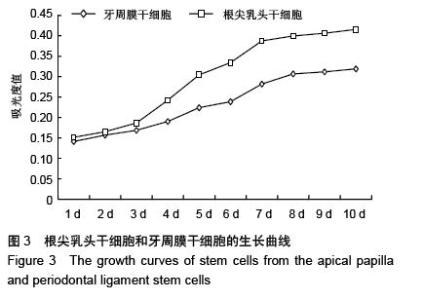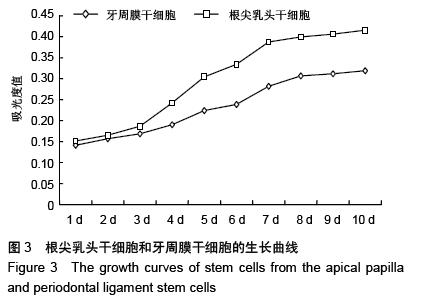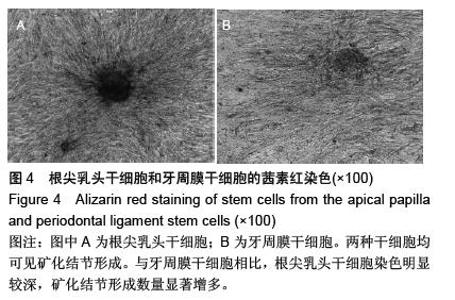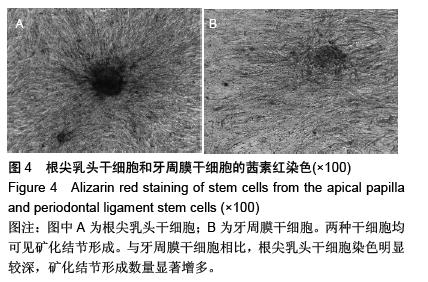Chinese Journal of Tissue Engineering Research ›› 2016, Vol. 20 ›› Issue (1): 113-117.doi: 10.3969/j.issn.2095-4344.2016.01.020
Previous Articles Next Articles
Stem cells from the apical papilla versus periodontal ligament stem cells: biological behaviors
Zhao Lu, Yu Li, Yuan Ping, Zhou Chun-mei, Wu Pei-ling
- Department of Stomatology, the Second Affiliated Hospital of Xinjiang Medical University, Urumqi 830063, Xinjiang Uygur Autonomous Region, China
-
Received:2015-11-03Online:2016-01-01Published:2016-01-01 -
Contact:Wu Pei-ling, Master, Chief physician, Doctoral supervisor, Department of Stomatology, the Second Affiliated Hospital of Xinjiang Medical University, Urumqi 830063, Xinjiang Uygur Autonomous Region, China -
About author:Zhao Lu, Studying for master’s degree, Department of Stomatology, the Second Affiliated Hospital of Xinjiang Medical University, Urumqi 830063, Xinjiang Uygur Autonomous Region, China -
Supported by:the Natural Science Foundation of Xinjiang Uygur Autonomous Region, No. 2015211C107
CLC Number:
Cite this article
Zhao Lu, Yu Li, Yuan Ping, Zhou Chun-mei, Wu Pei-ling . Stem cells from the apical papilla versus periodontal ligament stem cells: biological behaviors[J]. Chinese Journal of Tissue Engineering Research, 2016, 20(1): 113-117.
share this article
| [1] Sonoyama W, Liu Y, Fang D, et al. Mesenchymal stem cell-mediated functional tooth regeneration in swine. PLoS One. 2006;1:e79.[2] Sonoyama W, Liu Y, Yamaza T, et al. Characterization of the apical papilla and its residing stem cells from human immature permanent teeth: a pilot study. J Endod. 2008; 34(2):166-171.[3] Abe S, Yamaguchi S, Watanabe A, et al. Hard tissue regeneration capacity of apical pulp derived cells (APDCs) from human tooth with immature apex. Biochem Biophys Res Commun. 2008;371(1):90-93.[4] Bakopoulou A, Leyhausen G, Volk J, et al. Comparative analysis of in vitro osteo/odontogenic differentiation potential of human dental pulp stem cells (DPSCs) and stem cells from the apical papilla (SCAP). Arch Oral Biol. 2011;56(7):709-721.[5] Huang GT, Sonoyama W, Liu Y, et al. The hidden treasure in apical papilla: the potential role in pulp/dentin regeneration and bioroot engineering.J Endod. 2008;34(6):645-651.[6] 熊华翠,陈柯,黄义彬,等.人根尖乳头干细胞生成牙髓牙本质复合体的实验研究[J]. 南方医科大学学报,2013,33(10):1512-1516.[7] 中华人民共和国科学技术部.关于善待实验动物的指导性意见. 2006-09-30.[8] 司徒镇强,吴军正.细胞培养[M].北京:世界图书出版社,2007.[9] 王燕萍,吴锦涛,王子露,等.磷酸二氢钾对根尖牙乳头干细胞成牙及成骨向分化能力的影响[J].中华口腔医学杂志, 2013, 48(1): 27-31.[10] 高润涛,范志朋.过表达BCOR基因抑制根尖牙乳头干细胞成肌分化[J].口腔生物医学, 2013, 4(1):1-3.[11] 杜鹃,范志朋.NFkB信号通路在炎症根尖牙乳头干细胞中的作用[J].北京口腔医学, 2013, 21(1):9-12.[12] 刁树,杨东梅,范志朋.牙组织源性干细胞的微环境[J]. 中华口腔医学杂志, 2014, 49(4):254-256.[13] 姚睿,范志朋.组蛋白去甲基化酶KDM4B促进根尖牙乳头干细胞中成骨和成牙本质分化[J]. 北京口腔医学, 2013, 21(4): 181-184.[14] 杨海兵,韩萱,杨琳.血管内皮生长因子和转化因子β1基因调控人根尖乳头细胞矿化相关因子的研究[J]. 华西口腔医学杂志, 2012, 30(5):468-472. [15] 邱云,郑青,萧树东,等.干细胞微环境的体外模拟[J]. 中国组织工程研究与临床康复, 2011, 15(6):1123-1126.[16] 吴家媛,贾谦,李帅,等.MTA对人根尖牙乳头干细胞体外增殖的影响[J]. 齐齐哈尔医学院学报,2011,32(15):2400-2401.[17] Banchs F, Trope M. Revascularization of immature permanent teeth with apical periodontitis: new treatment protocol. J Endod. 2004;30(4):196-200.[18] Chueh LH, Huang GT. Immature teeth with periradicular periodontitis or abscess undergoing apexogenesis: a paradigm shift. J Endod. 2006;32(12):1205-1213.[19] Cotti E, Mereu M, Lusso D. Regenerative treatment of an immature, traumatized tooth with apical periodontitis: report of a case. J Endod. 2008;34(5):611-616.[20] Ding RY, Cheung GS, Chen J, et al. Pulp revascularization of immature teeth with apical periodontitis: a clinical study. J Endod. 2009;35(5):745-749.[21] Petrino JA, Boda KK, Shambarger S, et al. Challenges in regenerative endodontics: a case series. J Endod. 2010;36(3): 536-541.[22] Chen MY, Chen KL, Chen CA, et al. Responses of immature permanent teeth with infected necrotic pulp tissue and apical periodontitis/abscess to revascularization procedures. Int Endod J. 2012;45(3):294-305.[23] Jung IY, Kim ES, Lee CY, et al. Continued development of the root separated from the main root. J Endod. 2011;37(5): 711-714.[24] Huang GT, Yamaza T, Shea LD, et al. Stem/progenitor cell-mediated de novo regeneration of dental pulp with newly deposited continuous layer of dentin in an in vivo model. Tissue Eng Part A. 2010;16(2):605-615.[25] Gronthos S, Mankani M, Brahim J, et al. Postnatal human dental pulp stem cells (DPSCs) in vitro and in vivo. Proc Natl Acad Sci U S A. 2000;97(25):13625-13630.[26] 武曦,张纲,谭颖徽. Notch信号通路在牙髓干细胞增殖和分化中的调控作用[J]. 牙体牙髓牙周病学杂志, 2011, 21(5):298-302.[27] Morsczeck C, Götz W, Schierholz J, et al. Isolation of precursor cells (PCs) from human dental follicle of wisdom teeth. Matrix Biol. 2005;24(2):155-165.[28] 高东辉,李军,孙晶,等.牙周膜干细胞的研究进展[J].中国老年学杂志,2012,32(15): 3362-3364.[29] Seo BM, Miura M, Gronthos S, et al. Investigation of multipotent postnatal stem cells from human periodontal ligament. Lancet. 2004;364(9429):149-155.[30] 熊华翠.人根尖乳头干细胞与牙周膜干细胞体外生物学特性的比较研究[D].广州:南方医科大学,2013. [31] 鲁少文, 税艳青. 牙周膜干细胞的研究进展[J]. 国际口腔医学杂志, 2013, 40(6): 769-772.[32] 孙静.牙周膜干细胞巢与牙周组织再生[J]. 国际口腔医学杂志, 2011, 38(4): 460-462.[33] 马丽, 杨丕山, 王燕. 人牙根尖乳头细胞的培养及TNF-α 对其增殖的影响[J].上海口腔医学, 2010, 19(5): 525-529.[34] 刘彩奇,陈柯,黄义彬,等. TNF-α 对人根尖乳头干细胞增殖及分化能力的影响[J].口腔医学研究, 2014, 30(5): 392-395. [35] Huang GT. Pulp and dentin tissue engineering and regeneration: current progress. Regen Med. 2009;4(5): 697-707.[36] 黄义彬,陈柯,熊华翠.牙根持续发育期根尖乳头干细胞的研究进展[J].口腔医学研究, 2013, 29(5): 490-492.[37] 郭俊,杨健.人根尖牙乳头细胞分离、培养的研究[J].口腔医学研究, 2011, 27(11): 1010-1012. [38] 张瑛,宋莉.牙周膜干细胞的研究进展[J].中国组织工程研究与临床康复, 2011, 15(36): 6817-6820.[39] 董正谋,刘鲁川.牙周膜干细胞的研究进展[J].国际口腔医学杂志, 2012, 39(4): 519-522.[40] 郭俊,杨健.人根尖乳头干细胞及其在组织工程中的研究进展[J]. 国际口腔医学杂志, 2010, 37(5): 464-466. |
| [1] | Jiang Tao, Ma Lei, Li Zhiqiang, Shou Xi, Duan Mingjun, Wu Shuo, Ma Chuang, Wei Qin. Platelet-derived growth factor BB induces bone marrow mesenchymal stem cells to differentiate into vascular endothelial cells [J]. Chinese Journal of Tissue Engineering Research, 2021, 25(25): 3937-3942. |
| [2] | Chen Yang, Huang Denggao, Gao Yuanhui, Wang Shunlan, Cao Hui, Zheng Linlin, He Haowei, Luo Siqin, Xiao Jingchuan, Zhang Yingai, Zhang Shufang. Low-intensity pulsed ultrasound promotes the proliferation and adhesion of human adipose-derived mesenchymal stem cells [J]. Chinese Journal of Tissue Engineering Research, 2021, 25(25): 3949-3955. |
| [3] | Zhang Lishu, Liu Anqi, He Xiaoning, Jin Yan, Li Bei, Jin Fang. Alpl gene affects the therapeutic effect of bone marrow mesenchymal stem cells on ulcerative colitis [J]. Chinese Journal of Tissue Engineering Research, 2021, 25(25): 3970-3975. |
| [4] | Ruan Guangping, Yao Xiang, Liu-Gao Miyang, Cai Xuemin, Li Zian, Pang Rongqing, Wang Jinxiang, Pan Xinghua. Umbilical cord mesenchymal stem cell transplantation for traumatic systemic inflammatory response syndrome in tree shrews [J]. Chinese Journal of Tissue Engineering Research, 2021, 25(25): 3994-4000. |
| [5] | Mo Jianling, He Shaoru, Feng Bowen, Jian Minqiao, Zhang Xiaohui, Liu Caisheng, Liang Yijing, Liu Yumei, Chen Liang, Zhou Haiyu, Liu Yanhui. Forming prevascularized cell sheets and the expression of angiogenesis-related factors [J]. Chinese Journal of Tissue Engineering Research, 2021, 25(22): 3479-3486. |
| [6] | Chen Lei, Zheng Rui, Jie Yongsheng, Qi Hui, Sun Lei, Shu Xiong. In vitro evaluation of adipose-derived stromal vascular fraction combined with osteochondral integrated scaffold [J]. Chinese Journal of Tissue Engineering Research, 2021, 25(22): 3487-3492. |
| [7] | Wei Qin, Zhang Xue, Ma Lei, Li Zhiqiang, Shou Xi, Duan Mingjun, Wu Shuo, Jia Qiyu, Ma Chuang. Platelet-derived growth factor-BB induces the differentiation of rat bone marrow mesenchymal stem cells into osteoblasts [J]. Chinese Journal of Tissue Engineering Research, 2021, 25(19): 2953-2957. |
| [8] | Chen Xiao, Guo Zhi, Chen Lina, Liu Xuanyong, Zhang Yihuizhi, Li Xumian, Wang Yueqiao, Wei Liya, Xie Jing, Lin Li. Factors affecting the mobilization and collection of autologous peripheral blood hematopoietic stem cells [J]. Chinese Journal of Tissue Engineering Research, 2021, 25(19): 2958-2962. |
| [9] | Guo Zhibin, Wu Chunfang, Liu Zihong, Zhang Yuying, Chi Bojing, Wang Bao, Ma Chao, Zhang Guobin, Tian Faming. Simvastatin stimulates osteogenic differentiation of bone marrow mesenchymal stem cells [J]. Chinese Journal of Tissue Engineering Research, 2021, 25(19): 2963-2968. |
| [10] | Li Congcong, Yao Nan, Huang Dane, Song Min, Peng Sha, Li Anan, Lu Chao, Liu Wengang. Identification and chondrogenic differentiation of human infrapatellar fat pad derived stem cells [J]. Chinese Journal of Tissue Engineering Research, 2021, 25(19): 2976-2981. |
| [11] | Gao Yuanhui, Xiang Yang, Cao Hui, Wang Shunlan, Zheng Linlin, He Haowei, Zhang Yingai, Zhang Shufang, Huang Denggao. Comparison of biological characteristics of adipose derived mesenchymal stem cells in Wuzhishan inbreed miniature pigs aged two different months [J]. Chinese Journal of Tissue Engineering Research, 2021, 25(19): 2988-2993. |
| [12] | Cao Yang, Zhang Junping, Peng Li, Ding Yi, Li Guanghui. Isolation and culture of rabbit aortic endothelial cells and biological characteristics [J]. Chinese Journal of Tissue Engineering Research, 2021, 25(19): 3000-3003. |
| [13] | Dai Min, Wang Shuai, Zhang Nini, Huang Guilin, Yu Limei, Hu Xiaohua, Yi Jie, Yao Li, Zhang Ligang. Biological characteristics of hypoxic preconditioned human amniotic mesenchymal stem cells [J]. Chinese Journal of Tissue Engineering Research, 2021, 25(19): 3004-3008. |
| [14] | Qin Yanchun, Rong Zhen, Jiang Ruiyuan, Fu Bin, Hong Xiaohua, Mo Chunmei. Chinese medicine compound preparation inhibits proliferation of CD133+ liver cancer stem cells and the expression of stemness transcription factors [J]. Chinese Journal of Tissue Engineering Research, 2021, 25(19): 3016-3023. |
| [15] | Dai Yaling, Chen Lewen, He Xiaojun, Lin Huawei, Jia Weiwei, Chen Lidian, Tao Jing, Liu Weilin. Construction of miR-146b overexpression lentiviral vector and the effect on the proliferation of hippocampal neural stem cells [J]. Chinese Journal of Tissue Engineering Research, 2021, 25(19): 3024-3030. |
| Viewed | ||||||
|
Full text |
|
|||||
|
Abstract |
|
|||||







